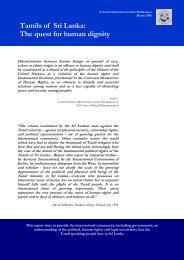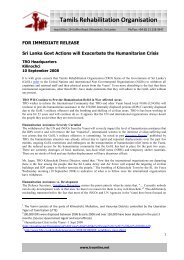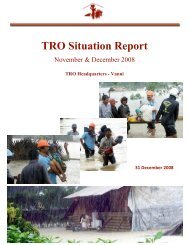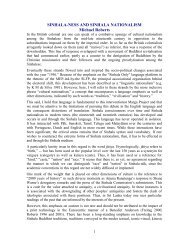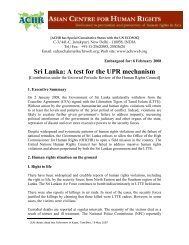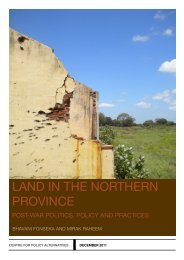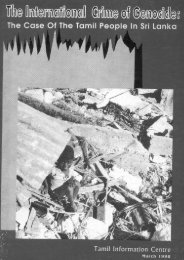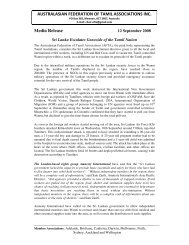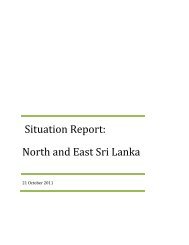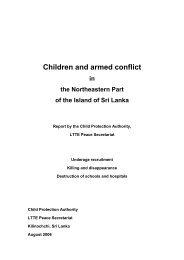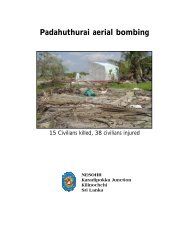Death of the Tiger - Ilankai Tamil Sangam
Death of the Tiger - Ilankai Tamil Sangam
Death of the Tiger - Ilankai Tamil Sangam
Create successful ePaper yourself
Turn your PDF publications into a flip-book with our unique Google optimized e-Paper software.
organization that had controlled much <strong>of</strong>nor<strong>the</strong>rn and eastern Sri Lanka for nearlya decade, it was a devastating reversal.Their remaining fighters, a force <strong>of</strong> aboutfifteen thousand, retreated into <strong>the</strong> junglenear <strong>the</strong> coastal town <strong>of</strong> Mullaittivu, takingalong more than three hundred thousand<strong>Tamil</strong> civilians who were trappedwith <strong>the</strong>m. With international concernmounting over <strong>the</strong> safety <strong>of</strong><strong>the</strong> civilians, <strong>the</strong> Sri LankanArmy designated a series <strong>of</strong>“no-fire zones” and told civiliansto assemble <strong>the</strong>re. It <strong>the</strong>nshelled those zones repeatedly,while issuing denialsthat it was doing so and forbiddingjournalists access to<strong>the</strong> area. Hundreds <strong>of</strong> peoplewere killed every day. By mid-April, <strong>the</strong> <strong>Tamil</strong> rebels and<strong>the</strong> civilians were trapped on a bloodystretch <strong>of</strong> beach about a mile long.Hemmed in by <strong>the</strong> sea, a lagoon, and ahundred thousand government soldiers,<strong>the</strong>y were all but helpless, as <strong>the</strong> Armykept up a barrage <strong>of</strong> fire from gunboats,aircraft, and field artillery.On April 21st, <strong>the</strong> Army broke through<strong>the</strong> <strong>Tiger</strong>s’ defenses, creating a chaoticcorridor that, over several days, allowednearly two hundred thousand famishedand wounded civilians to flee into itscustody. The Army had ordered mostrelief workers and all international observersto leave <strong>the</strong> area, but it none<strong>the</strong>lessbilled its <strong>of</strong>fensive as a “humanitarianoperation” to rescue hostages from<strong>the</strong> <strong>Tiger</strong>s. (The <strong>Tiger</strong>s did in fact preventsome civilians from fleeing, andshot hundreds <strong>of</strong> <strong>the</strong>m as <strong>the</strong>y tried toescape.) The <strong>Tiger</strong>s’ defenders, meanwhile,claimed that <strong>the</strong> Army was committinggenocide. Secretary <strong>of</strong> StateHillary Clinton admonished Sri Lanka’sgovernment, saying that “<strong>the</strong> entireworld is very disappointed” by <strong>the</strong> “untoldsuffering” that was being caused byits efforts to end <strong>the</strong> war. There werelater reports, which <strong>the</strong> government denied,that as many as forty thousand civilianswere killed during <strong>the</strong> Army’sfinal <strong>of</strong>fensive, and that <strong>the</strong>ir bodies wereburned or buried in secret mass graves.The foreign secretaries <strong>of</strong> France andGreat Britain flew to Sri Lanka, where<strong>the</strong>y pleaded with <strong>the</strong> government tocall a ceasefire in order to rescue <strong>the</strong> civilianswho were still trapped. Suspiciousthat <strong>the</strong> diplomats also wanted tosave <strong>the</strong> <strong>Tiger</strong> leaders, <strong>the</strong> governmentignored <strong>the</strong>m. Tens <strong>of</strong> thousands <strong>of</strong> civiliansremained in <strong>the</strong> kill zone, whichcontinued to shrink until it was no biggerthan four football fields.A survivor <strong>of</strong> <strong>the</strong> final stand at Mullaittivu,a young pastor, described <strong>the</strong>scene to me. He and four o<strong>the</strong>r pastorsand a group <strong>of</strong> sixty orphansin <strong>the</strong>ir care had been duginto shallow bunkers on <strong>the</strong>beach. “It was <strong>the</strong> first thingwe did whenever we reacheda new position—diggingand making bags with cutupwomen’s saris,” he said.“Only afterward would wego and look for food orwater.” The <strong>Tamil</strong> fighterswere in bunkers all around<strong>the</strong>m. “Most <strong>of</strong> <strong>the</strong>m were Black <strong>Tiger</strong>s,”he said, referring to <strong>the</strong> <strong>Tamil</strong> suicidesquad. “Prabhakaran was amongus, too, but none <strong>of</strong> us saw him.” He describeda charnel ground, with artilleryshells landing at random. “All we couldsee was dead people, people crying forfood and for water, and burning vehicleseverywhere.”On May 16th, Army troops took <strong>the</strong>last coastal positions, and, as <strong>the</strong>y pursued<strong>the</strong> remaining <strong>Tiger</strong>s, <strong>the</strong> Armycommander, General Sarath Fonseka,declared victory. The next day, a <strong>Tiger</strong>spokesman posted a statement on <strong>the</strong>organization’s Web site: “This battle hasreached its bitter end. . . . We have decidedto silence our guns. Our only regretsare for <strong>the</strong> lives lost and that wecould not hold out for longer.”In <strong>the</strong> bunker, <strong>the</strong> pastor’s grouptalked by cell phone with a brigadiergeneral in <strong>the</strong> Sri Lankan Army whotold <strong>the</strong>m to stay <strong>the</strong>re until <strong>the</strong>y sawsoldiers, <strong>the</strong>n identify <strong>the</strong>mselves withwhite flags. The group had run out <strong>of</strong>food and went foraging in an abandonedbunker nearby. “We found foodpackets—meat, chocolates,” <strong>the</strong> pastorsaid, and <strong>the</strong>y took as much as <strong>the</strong>ycould carry, dodging incoming fire.The next morning, a young man in<strong>the</strong>ir group was fatally shot as he defecatedoutside.By evening, <strong>the</strong>y could see soldiersapproaching. “Two or three <strong>of</strong> us wentout with several children, and we tookwhite flags, as <strong>the</strong> brigadier had suggested,”<strong>the</strong> pastor recalled. “But as weapproached <strong>the</strong>y said, ‘Don’t come,’ andfired guns in <strong>the</strong> air.” The soldiers hadbeen told <strong>the</strong>re could be suicide bombersamong <strong>the</strong> last <strong>Tiger</strong>s, and in factseveral insurgents blew <strong>the</strong>mselves up in<strong>the</strong> midst <strong>of</strong> civilian refugees turning<strong>the</strong>mselves in to <strong>the</strong> Army. “We fell on<strong>the</strong> ground. They were about fifty metresaway. We crawled back to <strong>the</strong> bunker,and <strong>the</strong>n <strong>the</strong>y fired at <strong>the</strong> bunker. Thewhole night, I could hear <strong>the</strong> Armythrowing grenades in <strong>the</strong> bunkers nearus. There were explosions, and peoplewere crying and saying, ‘Help us.’ ”At dawn, <strong>the</strong> pastor said he “feltcourage” and decided to go out and confront<strong>the</strong> soldiers. “I went with ano<strong>the</strong>rpastor and a white flag,” he said. “Weexplained who we were, and <strong>the</strong>y toldeveryone to come forward out <strong>of</strong> <strong>the</strong>bunker. They ordered us to kneel down.There were about fifteen soldiers. Theirfaces were covered with black cloth.One soldier said, in Sinhala—I understanda little—‘We have orders to shooteveryone.’ We were shouting for <strong>the</strong>mnot to shoot.” After a tense stand<strong>of</strong>f, <strong>the</strong>pastor was strip-searched, along with<strong>the</strong> children, and <strong>the</strong>n allowed to collecthis belongings from <strong>the</strong> bunker. “Apastor came behind me, but he waspunched in <strong>the</strong> chest by a soldier. Hefell down. He died later that day. Thesame soldier who hit him stuck hisfingers in <strong>the</strong> wounds <strong>of</strong> <strong>the</strong> young menwith us who had been injured.”After ano<strong>the</strong>r strip search and a longinterrogation, <strong>the</strong> pastors were reunitedwith <strong>the</strong> children and put in a detentioncamp. When I asked <strong>the</strong> pastor how<strong>the</strong> experience had affected him, hesaid, “It is in my mind. When I sleep,automatically it comes out—things Ionly saw in films in my youth. Bodieswithout heads. Bodies with <strong>the</strong> stomachopen and <strong>the</strong> liver coming out.” Headded, “At <strong>the</strong> end, we were walkingout through fire and past dead people,and <strong>the</strong> soldiers were laughing at us andsaying, ‘We have killed all your leaders.Now you are our slaves.’ You can imaginehow I feel about my country.”On <strong>the</strong> same day, May 18th, <strong>the</strong>Army announced that <strong>the</strong> <strong>Tiger</strong>leader, Velupillai Prabhakaran, hadbeen killed, along with two hundredand fifty o<strong>the</strong>rs, during an overnight42 THE NEW YORKER, JANUARY 17, 2011




